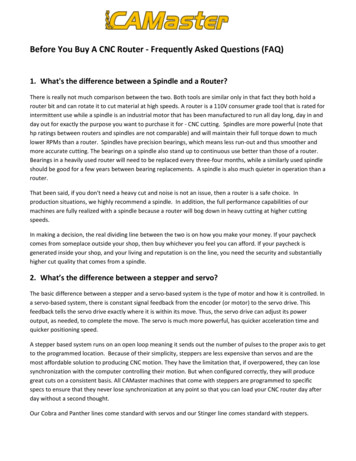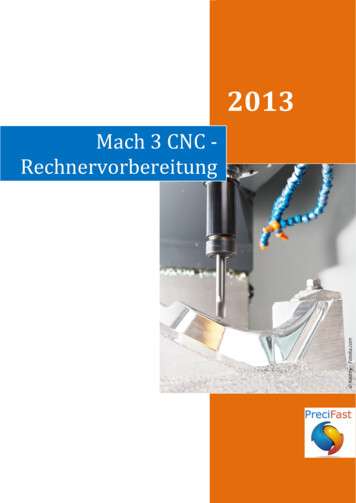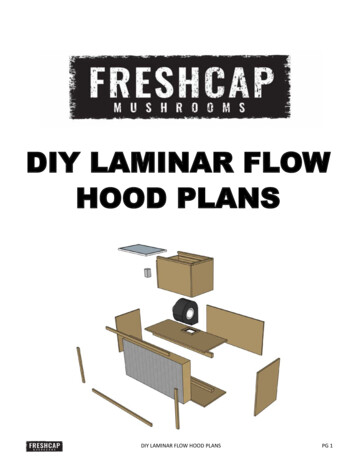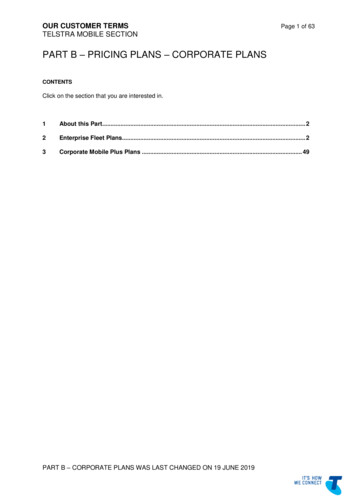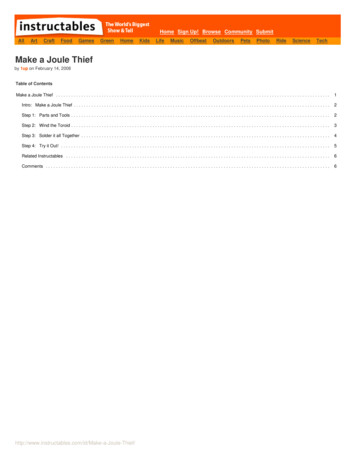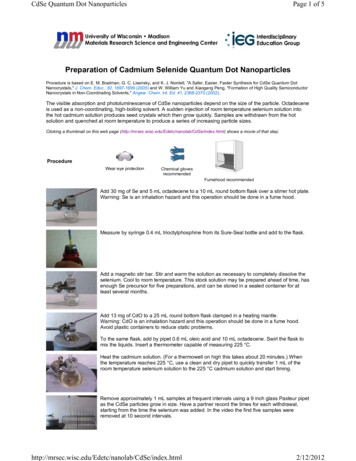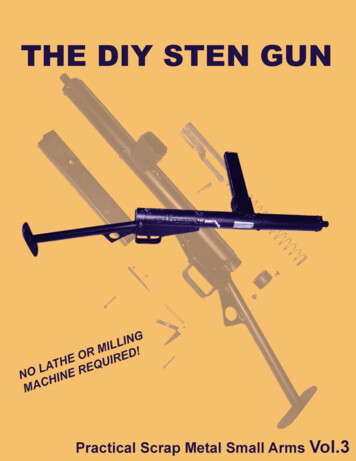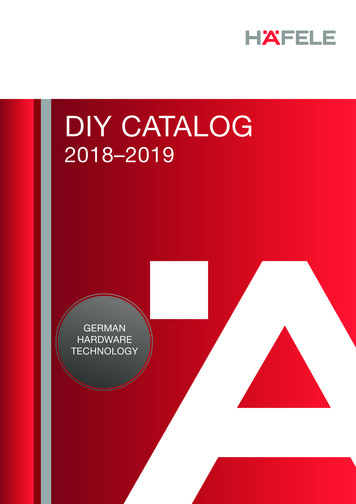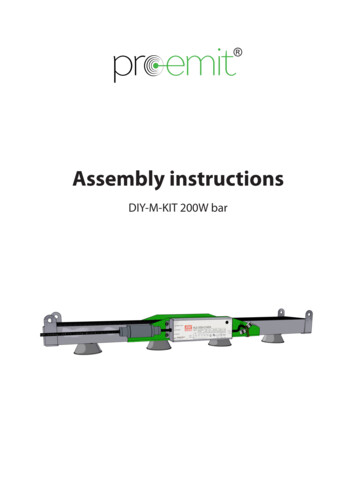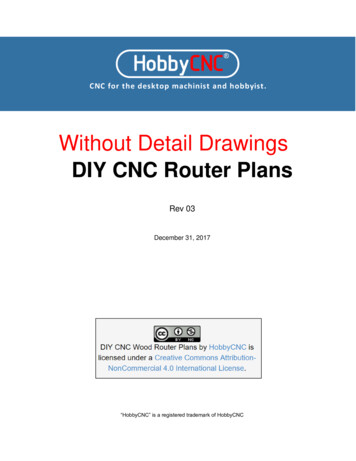
Transcription
Without Detail DrawingsDIY CNC Router PlansRev 03December 31, 2017“HobbyCNC” is a registered trademark of HobbyCNC
DIY CNC Wood Router PlansForwardThese plans are based on the second DIY CNC Router that I made. I made every effort to ensure themeasurements are accurate, however, I strongly recommend you verify everything before you startcutting! These plans are provided “as is”, with no warranty or guarantee.Building your own 3-Axis CNC router is both fun and educational. These plans document all the stepsI followed to make my DIY CNC Router. This is the second DIY CNC Router I made, after learning alot from building the first version.This is a very good router that can be built at a reasonable price using readily available materials. Thisdesign uses DIY linear bearings, threaded rod and plywood (or MDF) construction. No fancymaterials, no expensive drive screws. This is a hobby router project. It is a router designed to routewood, plastic and some aluminum. It is a low-cost, decent quality system that will teach you all youneed to know about 3-axis routing.If you take care during cutting and assembly, you can achieve very good accuracy. I also use mine todo printed circuit board isolation routing, and I can do surface-mount ICs with 50mil (.050”) pitch. Notbad at all!I’m proud to report that over 1,000 copies of these plans have been downloaded.DIY Router Plans, HobbyCNC, Rev03Page 2 of 47
DIY CNC Wood Router PlansTable of contentsDiscussion Forum . 4My Machine in Action . 4Material Selection . 4Other things to consider. 6Cutting Diagram. 8Parts List . 9The Base . 10The Cross-Dowel Jig . 15The drive nut and anti-backlash assembly . 18Linear Bearings . 21The X-Axis . 23The Y-Axis . 25Stepper Motor Mounting . 30Electronics . 32Limit Switches . 34Stepper Motor Wiring . 36Cable Management . 40Wiring the electronics . 43Glossary . 44Change Log . 46Drawings . 47DIY Router Plans, HobbyCNC, Rev03Page 3 of 47
DIY CNC Wood Router PlansDiscussion ForumIf you have questions or suggestions regarding these plans, please post to the HobbyCNC DIY CNCRouter Plans forum (hobbycnc.com/forums/forum/diy-cnc-router-plans/). By using the forum you canenhance the community by sharing your questions, answers and your build progress.I’d love to post photos of your build on my HobbyCNC Customer Builds page(hobbycnc.com/customer-builds/) – send photos to brian@hobbycnc.com or post your photos to theforum.My Machine in ActionIf you want to see my build actually doing something, I made a short video (1 min, 34 sec) of itmachining some HobbyCNC PRO heat sinks. Vimeo Heatsink Video (vimeo.com/166901487).Material SelectionPreferred: High quality, furniture-grade plywood. Both good looking and strong.OK: MDF (Medium Density Fiberboard)Not good: Particle Board, ‘regular old plywood’This DIY CNC Router is made out of wood. I would strongly recommend high quality, furniture-gradeplywood. It is both good looking and strong.The other option is MDF (Medium Density Fiberboard). Not recommended is Particle Board or"regular old plywood". Furniture Grade Plywood is constructed with many fine layers of alternating grain. It istypically free of voids and is surfaced with a clean veneer that looks great when finished. It isalso damn strong and resists bending well. MDF is made of very fine, evenly distributed material. It is heavy and dimensionally stable. It iseasy to cut (but can dull blades quickly). It's mortal enemy is water. My first build was withMDF & scrap plywood. It worked well and was perfect for experimenting. Build number 2 waswith a high-quality furniture grade plywood. Regular old plywood. I found local home-store type plywood to be too full of voids andimperfections to be worthwhile.DIY Router Plans, HobbyCNC, Rev03Page 4 of 47
DIY CNC Wood Router Plans Particle board can easily be identified by the very coarse and uneven density. It is cheap andnot strong. Do not go there.My first build (with MDF and scrap plywood) worked OK (it just wasn’t square) and was perfect forexperimenting. Build number 2 was with a high-quality furniture grade plywood.I’ve also been told that there is a “High Density Fiberboard”, but I have no experience with it. Soundslike it should work well too.Hardboard, also called high-density fiberboard (HDF), is a type of fiberboard, which is an engineered woodproduct.It is similar to particle board and medium-density fiberboard, but is denser and much stronger and harderbecause it is made out of exploded wood fibers that have been highly compressed. Consequently, thedensity of hardboard is 31 lbs or more per cubic foot (500 kg/m³)[2] and is usually about 50-65 lbs per cubicfoot (800–1040 kg/m³). It differs from particle board in that the bonding of the wood fibers requires noadditional materials, although resin is often added.Retrieved from https://en.wikipedia.org/wiki/Hardboard, Dec 2018SizeMy build is 24 x 36 inches. I’m not confident to go any larger as wood does flex under load.Attention to detailIt is critical that all cuts are as perfectly square as you can make them. I was in a hurry for my firstbuild and the problem became evident when I milled “mirror opposite” parts that did not line up toeach other after milling! D’oh!Straight, true, accurate cuts during assembly are very important to ensurea great quality outcome!Holding it all together - Barrel (or Cross Dowel) NutsUsing a jig is highly recommended. Instructions for creating the jig are onpage 15DIY Router Plans, HobbyCNC, Rev03Figure 1 - Barrel or CrossDowel nutPage 5 of 47
DIY CNC Wood Router PlansOther things to considerCNC Router storage – think about this when you are sizing your machine. Bigger is cool, and youcan fit more and larger ‘stuff’ into it, but you have to store the thing when you are not using it. Andwhen you are using it, you need space to get around it (mine is on wheels, and on a dedicatedcabinet).Tooling Storage - You will also likely end up with associated tools, tooling, spindles, clamps,wrenches, dial gauges, and on and on. Plan on a lot more ‘stuff’ than you initially think. Plan to havesome dedicated space near (or in my case, under) the machine for ready access during setup and fortool changes.Noise – they are pretty quiet – until you start the spindle, and louder yet when the tool hits the workpiece. Have a good set of ear and eye protection handy AND USE IT.Dust / Mess – if you are routing wood, these things generate a LOT of sawdust. And it getsEVERYWHERE (this is the primary reason I don’t recommend laptops in the shop!). Consider a dustremoval system (not discussed in this document). Machining MDF sends A LOT of fine dust into theair. I can’t imagine any of it is good for your lungs. If you are going to mill in a small space or with poorventilation and without any type of dust extraction, wear a dust mask.Smell – If you are engraving metals and use a coolant or lubricant – some of them really smell.Multiply that by 100 if you use a mist-type system.Clamping – nothing is more frustrating than the work piece moving inthe middle of a run. I have come to learn that clamping is an art form.This is why I suggest “T tracks” in the bed of the router table. Thisallows use of inexpensive woodworking clamps – or make-your-ownclamps. One can never have too many clamps.Leveling the work piece – I did not realize how critical it is to use a dialgauge and level your work piece or base before you start. Especiallyengraving or milling PC boards – a few thousandths makes a bigdifference. Figure 2 shows a Harbor Freight part – under 20. It ismandatory in my opinion.Figure 2 - 1 inch Travel Machinist'sFor milling PC Boards, (which have a naturally wavy surface, I haveused leveling software with very good success.Dial Indicator (Harbor Freight)Two of my most interesting learning experiences were: the importance (and difficulty) of leveling your work piececlamping the work piece – clamps must be firm, plentiful and out of the way ofthe tool and any moving parts.DIY Router Plans, HobbyCNC, Rev03Page 6 of 47
DIY CNC Wood Router PlansLearning the software – you have at least two (and possibly three) bits of software to get competentwith:CAD – somehow, somewhere, you need to design what you are going to machine. You can useGoogle Sketchup for some tasks. It is free and probably the easiest to learn. There is ProE andAutocad and other high-end, parametric CAD software, that is super-powerful (and quiteexpensive). And there is a huge array in-between.I have started using Autodesk Fusion 360. It is a full-function, parametric-driven CAD software andit is free to makers, students and small business with annual revenue under 100k. It is anamazing product that supports g-code creation and 3D printing.The free Start-Up/ Enthusiast licenses allow you to access Fusion 360 Ultimate with a yearly subscriptionafter the trial period has ended. You can use this license if you are a small business making less than 100,000 per year (or equivalent), or if you're a hobbyist using Fusion 360 for non-commercial purposes.Retrieved from: sion-360.html,Dec 2018CAM: G-Code Creation – this can be built-in to the CAD software (like Fusion 360), or it can be aseparate software (I use CamBam). This is where you decide which tools to cut with (shape,length, diameter), how fast, how deep each pass is, whether the tool cuts “inside” or “outside” theline, create holding tabs, define the order of operations, types of operations (e.g. drill, pocket,engrave).CAM: Machine Control– this is the software that actually drives the stepper motors. It takes theG-Code from the previous step and converts it into the proper movement of the three axis. Somecommon CAM software is LinuxCNC (free), BobCAD, Mach3.Cost – The HobbyCNC board, stepper motors can be as little as 150 USD (HobbyCNC EZ 3130oz-in stepper motors) or the HobbyCNC PRO 3-axis & 3 305oz-in for 220 USD (Check theHobbyCNC website for current pricing). A 32V 10A DC power supply will be around 75 to 100 USD(a regulated switching supply works fine too). Other materials (and this is a guess) would be around 300 USD. This would be for the CNC Router only, no dust control, no noise control, no cabinet, nospindle, no tools/bits. I’d budget 6-800 USD – again I did not cost-out the BOM, this is just a SWAG1.Cheap Import Electronics – My daddy use to say “the lowest price is not always the best value”.Caveat Emptor.Time – it takes time to build the machine. And time to learn all the associated software.Fun – it is super-rewarding to see the sawdust fly and your design come into reality. You will be calleda Geek by all your friends. Wear it with pride.Safety – these tools have a lot of power, and, although generally well-behaved, they can do someunexpected things. Be safe, wear hearing and eye protection, as well as a mask if there is dust, andkeep your hands away from pinch points (there are many of them).1Scientific Wild-Assed GuessDIY Router Plans, HobbyCNC, Rev03Page 7 of 47
DIY CNC Wood Router PlansCutting DiagramDrawing 1001All the parts for this machine can be cut from a single sheet of ¾” stock. I’ve prepared a cutting guide.I’ve laid-out the parts such that the sheet can be cut into six sections for easier handling.Important notes when cutting components Take your time and ensure everything is P E R F E C T Y square. If not, you will routeparallelograms instead of squares! When cutting identical parts, make sure to set-up your saw one time and make all the cuts. It ismost important that related parts are the same sizeA 1/8” Kerf is assumed for this drawing. Adjust for your blade width. Cut parts a little oversize andfinish-trim to the precise dimensions.Figure 3 - Drawing 1001 Cutting GuideDIY Router Plans, HobbyCNC, Rev03Page 8 of 47
DIY CNC Wood Router PlansParts QtyDescription1261/4-20 x 2" Hex Head Bolts261/4-20 x 1 ½" Hex Head Bolts391/4-20 Hex Nuts33421/4-20 Acorn Nut11511/4-20 Jam Nut6321/4" USS Flat Washers2887781/4-20 threaded rod (inches)3828128245/16-18 x 3/4" hex bolt9245/16-18 hex nut101210-32 x 3" Cap Head machine screws1110#8 x 2" flat head wood screw101237#8 x 1 1/2" flat head wood screw37136#8 x 3/4 flat head wood screw146#6 x 3/4 round head wood screw1512#4 x 3/4" pan head wood screws1612T-Nuts 10-32176T-Nuts 1/4-20Rockler # 260541826Barrel Nuts / Threaded cross dowelsRockler # 31823191783/4 x 3/4 x 1/8 Al Angle 6061 or 63 (inches)206Bearing, R4ZZ, 1/4" x 5/8" x 0.196"VXB Bearing R4ZZ-12124Bearing, 608ZZ, 8x22x7mmVXB Bearing 608ZZ222363Limit SwitchesStepper MotorsJameco 2117333HobbyCNC 23-305,23-205 or 23-130243Flexible Shaft CouplingVXB Bearing 6-35X10 COUPLING253Mending BraceGranger 4PB673263Steel Compression SpringMc-Master Carr 9657K1563273Coupling NutMc-Master Carr 90264A43532831/4-20 Square Nut293031Small angle bracketPlywood Sheet, 4' x 8'DIY Router Plans, HobbyCNC, Rev03Part NoStepperMotorsItem #631862424Length depends126648222887048202222412104024333Keystone 6173Page 9 of 47
DIY CNC Wood Router PlansThe BaseDrawings 1002 through 1008A strong, sturdy base is requisite for quality results. For this, I recommend a torsion box design. Atorsion box will provide a strong, stable yet light weight base for your project.In addition to strength and flatness for milling provided by a torsion box, remember thatANY FLAT SURFACE in your garage or shop has a high likelihood of collecting ‘stuff’and becoming a storage space. Without a strong base, a pile-o-crap sitting on your millbed for a long time can warp it.Figure 4 - Exploded View of the Base (Drawing 1008)The base is the most complex of all the components. Extra care must be taken to ensure the entireBase assembly is square and flat.I designed the Base Linear Bearing Rail Supports (Figure 9) to be particularly robust as this supportsthe Y and Z gantries as well as the cutting tool.The design recesses the Base Linear Bearing Rail Supports underneath the Base Top (Drawing1007) in an effort to minimize contamination by sawdust and to somewhat protect another pinch-point.This made assembly a bit more complex, but the results are worth the effort.Sacrificial TopIn Figure 4, you will notice there are two “tops” to the Base assembly. The lower of the two tops is part of the Torsion Base, and is screwed to the underlyingframework, becoming the final part of the torsion box.The upper of the two tops is a “sacrificial” top board which is a replaceable 24 x 36” piece ofMDF with “T” slots cut into it. This can be easily replaced if it becomes damaged.DIY Router Plans, HobbyCNC, Rev03Page 10 of 47
DIY CNC Wood Router PlansAssemble the Torsion BaseNOTE: The thickness of your stock will vary based on the type of material you use. MDF istypically 3/4 of an inch thick, whereas 3/4” plywood is 23/32” (0.71875”). So cut the slots inthe Torsion Base frame to fit your stock. The tighter the tolerance the better.Figure 5 – Illustration of coreFigure 6 – Actual coreIMPORTANT: Assemble the Torsion Base frame upside down on a VERY FLATSURFACE. Make sure the frame is sitting flat and flush against the flat work surface.Torsion Box Internal FrameWhen cutting the notches, use double-sided tape, or otherwisebind all the similar parts together, so you make only one set of cutsfor all like pieces.If you don’t have some 90 woodworking clamps (see Figure 6). Iwould suggest making some before you begin glue-up (Figure 7).Adjust the dimensions to match your project.IMPORTANT: Assemble the Torsion Base frame upside down on a VERYFLAT SURFACE. Make sure the frame is sitting flat and flushagainst the flat work surface. Add weights if necessary. Put down paper to prevent glue from ruining the table. Allow the Torsion Base core to dry thoroughly before the nextstep.This step benefits from two people working together.After test-fitting all parts, apply glue liberally on both mating piecesof wood.DIY Router Plans, HobbyCNC, Rev03Figure 7 - Right Angle Clamp clamping-tasks/Page 11 of 47
DIY CNC Wood Router PlansBase End PanelsAttach the Base End Panels with wood screws (Figure 8). Keep the Torsion Base core face-down onthe flat surface while attaching the front and back. The Torsion Base core is centered on the Base Frontand Rear panels. Attach with glue and screws.Two end-panels are added (Figure8) to hold the Torsion Base up offthe work surface providing spacefor the axis drive screw the X-Axisassembly to slide under.Put the end panels on with thebase upside-down – the topagainst the flat surface.The stepper motors are addedlater and are the same for all axis.See page 30Figure 8 - Attach Base End panels. Assemble upside-down (as shown) on flatsurfaceBase Linear Bearing Rail SupportsFor the Base LinearBearing Rail Supports(Figure 9), it is critical thatthese are very carefullyassembled so everythingremains square and true.Dry-clamp the parts, ensurethat all three pieces havetheir back end (facing awayfrom us in Figure 9) flush andstraight.Figure 9 - Base Linear Bearing Rail Supports (Drawing 1004)Drill pilot holes for thescrews. Remove the clamps, glue, re-clamp and screw together. Keep clamped until glue sets-up.DIY Router Plans, HobbyCNC, Rev03Page 12 of 47
DIY CNC Wood Router PlansAttach Base Linear Bearing Rail SupportsGlue-and screw the Base Linear Bearing Rail Supports (Figure 9) to the Torsion Base (Figure 10).Assemble upside-down on a flat surface, all parts must be flush at the top.Figure 10 - Install Base Linear Bearing Rail Supports (shown upside-down)Figure 11 - Underside of my Torsion Base (as built)DIY Router Plans, HobbyCNC, Rev03Page 13 of 47
DIY CNC Wood Router PlansTest the fit of the X-Axis Gantry onthe Torsion base (Figure 12) beforeattaching the top of the Base Top.Screw the Base Top in place.Sacrificial TopUsing only 4 small wood screws, onein each corner, attach the BaseSacrificial Board to the Base Top(no glue).To aid in clamping work duringmilling, I recommend cutting T-slotsinto the sacrificial top (Figure 13).This will come in VERY HANDYwhen you start milling. One thingthat I really learned to appreciatewas just how important (and difficult)properly securing your work-piece isbefore milling.SummaryFigure 12 - Torsion Base (without top) test X-Axis gantryYes, the torsion box method requires a lot of parts-pieces. Ibelieve you need a super-sturdy base to support all the workthat will be going on above it!Figure 13 - T-Slot router bit and T-slotRockler.comDIY Router Plans, HobbyCNC, Rev03Page 14 of 47
DIY CNC Wood Router PlansThe Cross-Dowel JigI went the extra mile and used a tongue-and-groove approach on all joints to be double-damn-sureeverything went together square (the “belt-and-suspenders” approach).The drilling jig using brass bushings the size of the bolt (1/4” in my case) and the barrel nut (3/8”) thatwould allow me to drill perfectly aligned holes without having to measure (a HUGE time saver).In addition to drawing a center line, I also added ruler markings to the underside to speed thealignment process, for example, drilling 1 1/2" in from the edges (Figure 16).In Figure 17 I have inserted two drill bits (1/4” and 3/8”) backwards to give you a visual of how theholes will line up.Figure 14 – Cross Dowel Jig, top viewFigure 15 – Cross Dowel Jig, side viewFigure 16 – Cross Dowel Jig, bottom view, note inchmarkingsFigure 17 – Cross Dowel Jig with drill bits inserted to seealignmentTo use the jig, carefully line up the parts to be drilled and mark where the holes are to go. Clamp thejig over the parts and drill both target parts at one time, without removing the clamps (Figure 18).Having two drill motors (one with a 1/4” drill and one with a 3/8” drill is super handy).DIY Router Plans, HobbyCNC, Rev03Page 15 of 47
DIY CNC Wood Router PlansThe 3/8” drill goes completely through the stock. For the ¼” drill, mark the drill bit with tape to indicatehow deep to drill. The ¼” hole will need to go past the 3/8” hole to allow space for the bolt to passthrough.Figure 18 - Drill jig in place over parts to be drilled (light blue)The threaded hole in the Cross Dowel Nut may be in the center,or it may be offset. Adjust the position of the ¼” bushing asnecessary for your CrossDowel Nuts. The 1⅛” dimension in Figure 22 will drill the ¼” holein the center of the part. Move up-or-down as necessary for yourCross Dowel Nuts. Try on some scrap pieces first!Figure 21 includes a ¼-20 x 2” bolt to show the position of theCross Dowel nut.Figure 19 - Cross Dowel cutaway viewEnsure the part is square during assembly.You can also purchase pre-made jigs (Figure 20) forexample: http://www.woodpeck.com/crossdoweljig.htmlFigure 20 - Woodpeckers Cross Dowel Drill JigDIY Router Plans, HobbyCNC, Rev03Page 16 of 47
DIY CNC Wood Router PlansFigure 21 - Drill jig top view with 2” bolt for referenceFigure 22 - Drilling jig front viewFigure 23 - Drilling jig, assembledDIY Router Plans, HobbyCNC, Rev03Page 17 of 47
DIY CNC Wood Router PlansThe drive nut and anti-backlash assemblyDrawing 1026, 2 pages. You will need three of these assemblies.I have employed this solution and I find it works quite well. Once I added the anti-backlashcomponent, the quality and accuracy during PCB milling was improved considerably.Drive nutIt is made of a standard Hex Coupling Nut and a Stanley 118 Mending Brace. These need to becarefully aligned and welded to form a strong, single piece.It is secured to the axis by two #8 x 3/4 flat head wood screws.Caution: Use extra care when mounting this part to avoid any binding or bending of the drive screw.The fit should be as passive as possible.Anti BacklashTo improve repeatability for finework like PCB isolation routing, Ineeded to eliminate backlashwhich was causing wavy, uneventraces during etching. I came upwith a simple and effectivesolution that used a square nut, aspring and two small L brackets.The idea is to ‘loosely retain” thespring between the square nutand the lead screw nut, therebyalways ‘pushing’ the lead screwaway from the square nut (whichremains fixed to the lead screw).Change the spring to impact theamount of backlash control.Adjust the distance between thecoupling nut (#27) and theFigure 24 - Drive nut and anti-backlash assemblysquare nut (#25) to provide theproper tension (e.g. “whatever feels about right”) on the spring, then ‘loosely capture’ the nut betweenthe two L brackets (with #6 x 3/4 wood screws). This will ensure the square nut remains the exactdistance from the lead screw nut.The square nut should not be “pinched” tightly between the L brackets, but just close enough toprevent the square nut from turning.DIY Router Plans, HobbyCNC, Rev03Page 18 of 47
Figure 25 - Drive nut and anti-backlash assembly, explodedDIY CNC Wood Router PlansDIY Router Plans, HobbyCNC, Rev03Page 19 of 47
DIY CNC Wood Router PlansExample with and without anti-backlashFigure 26 is a microscope image (20x) of an early PC board etch. The pads (going diagonal frombottom left to top right) are .050” on center. Notice the wavy traces coming off the padsThe trace in Figure 27 (same magnification) is clean and crisp. The trace is a narrow because I hadmy depth-of-cut a bit too deep. Still worked, though.Figure 26 - Without anti-backlashDIY Router Plans, HobbyCNC, Rev03Figure 27 - With anti-backlashPage 20 of 47
DIY CNC Wood Router PlansLinear BearingsDrawings 1021, 1022, 1027This is another big area where our simple plywood CNC Router design is different than "real" mills the approach used here is a very inexpensive implementation that will still yield acceptable results fora Hobby CNC Router. This system uses a very simple and inexpensive linear bearings using ¾”aluminum angle (6061 or 6063) and skateboard bearings. If made right, it is quite rigid and durable. Iwould imagine you could substitute steel angle for the aluminum. Don't know for sure, didn't try it.Care must be taken to drill the mounting holes E X A C T L Y the same distance from the corner of thealuminum angle stock. This will determine how well all four bearings ride against the opposing angleand distribute the forces.Put the bolt through the bearing and follow this with anut. Tighten to secure the bearing. No washer. Thenplace the bolt/bearing/nut assembly into the threadedhole in the angle bracket.If your 5/16" bolts are too long, you can offset theholes for the bearings, as long as you respect theidentical distance from the apex of the angle. Thereare four 8 inches long and two 4 inches long. Otherthan the length, the construction is identical. Drill-andtap all holes 5/16-18. Assemble as shown.Build one and test for proper clearance (Figure 30)before drilling all the parts.Figure 29DIY Router Plans, HobbyCNC, Rev03Figure 28 - 4" Linear Bearing AssemblyFigure 30 – Test for clearancePage 21 of 47
DIY CNC Wood Router PlansLinear Bearing SupportThe Linear Bearing Support isa small “house shaped” strip ofmaterial that sits between theLinear Bearing and theassociated gantry, coloredorange in Figure 32. These arecut intentionally long . You willneed to make a few “trial anderror” attempts at getting thebearing support the rightlength.You will also need to removesome material from the bearingsupport where the 5/16” boltsstick through the aluminumangle (Figure 31).Figure 31 - Linear Bearing Support (8 in) showing recesses for boltsShimming the linear bearingsThis part of the assembly is testmodify-test-modify until you getthe linear bearings riding firmlyagainst the opposing rails.If you need to shim it, you canput shim stock between theLinear Bearing and the LinearBearing Support or betweenthe Linear Bearing Supportand the gantry. You can usecut-up soda cans, or you canuse the ‘fingers’ from aninexpensive feeler gauge.For my build, I used businesscards. Probably notrecommended, but it did workfor me.Figure 32 - Linear Bearing Mount (orange)I also counter-sunk a hole in the dead-center of the Linear Bearing to accommodate a small, flathead screw (not shown) to hold the linear bearing in place during assembly and disassembly.DIY Router Plans, HobbyCNC, Rev03Page 22 of 47
DIY CNC Wood Router PlansThe X-AxisDrawings 1009 through 1012.The X-Axis slides along the Base, front-to-back. As with all the parts, care in cutting and layout areimportant to ensure a quality output from your router.Carefully align the X-Axis Linear Bearing Nut and anti-backlash parts perpendicular and on thecenter line of the X-Axis-Bottom.Now bolt the X-axis together around the Base (Figure 12). Test the bearings for a snug - but freemoving - fit. Shim or trim as necessary to get a perfect fit.Slide the axis forward and backward to ensure smooth movement with no binding. At each end ofmovement, verify and mark the Base-End-Panels where you will drill the holes for the drive screw.After you have adjusted for a perfect fit, glue (or screw) the Linear Bearing Supports onto the X-Axissides. Optionally attach the 8” Linear Bearing Assemblies (I put a small, flathead screw dead-centerto hold it in place - not shown).Slide the X-Axis drive screw through one side of a Base-End-Panel, add the small square nut (part ofthe anti backlash assembly), then the spring, then thread into the X-Axis Drive Nut and Antibacklash Assembly, making sure the spring is well compressed. An electric drill carefully clampedon one end of the threaded rod will speed up this process.Add bearings to both ends of the X-Axis drive screw and double-nut (See Drawing 1102) making surethere is some tension on the threaded rod to keeping it from "flopping around" at higher speeds.Mount the limit switches with one screw only. Wait until assembly is completed to ad
it is free to makers, students and small business with annual revenue under 100k. It is an amazing product that supports g-code creation and 3D printing. CAM: G-Code Creation – this can be built-in to the CAD software (like Fusion 360), or it can be a separate software (I use CamBam).
